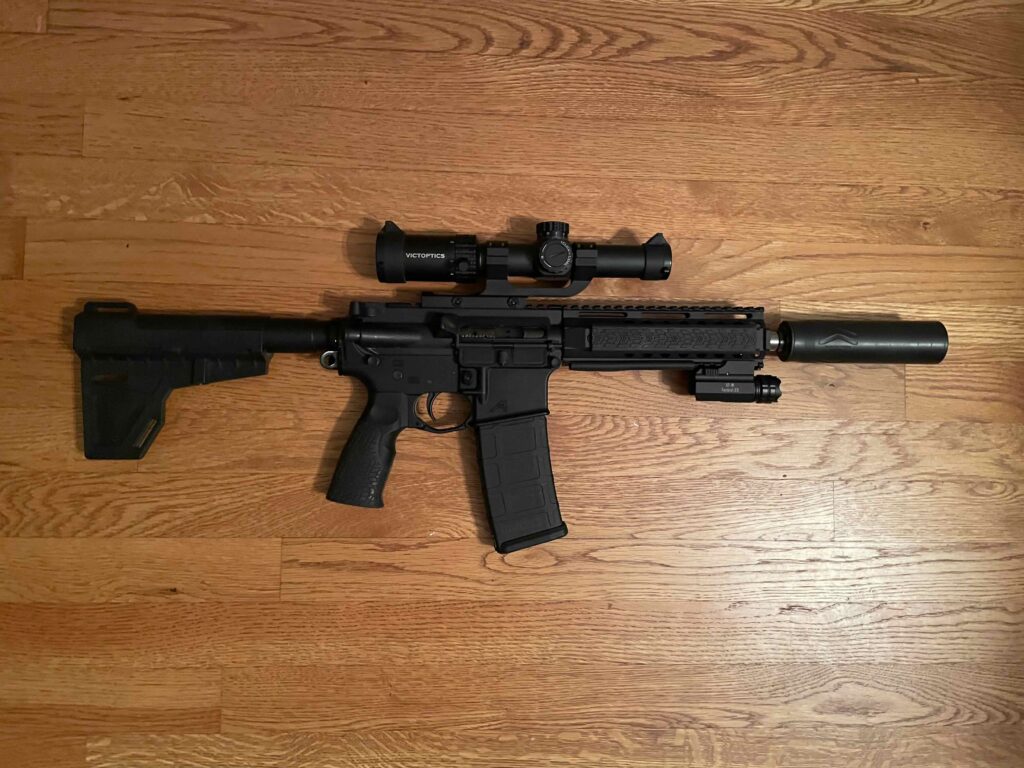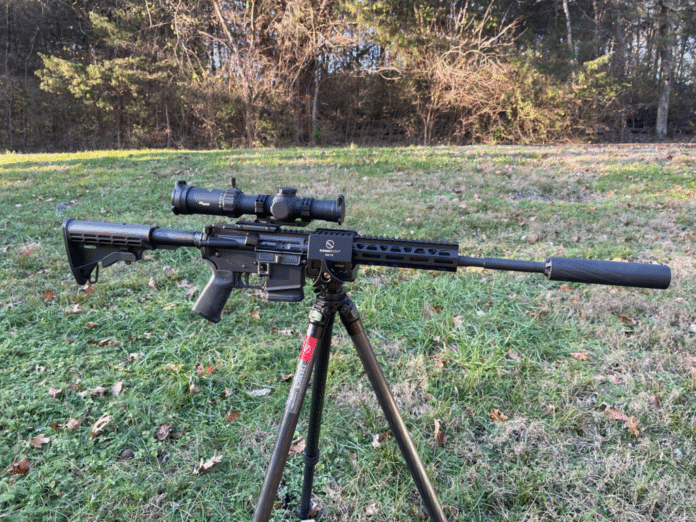The debate over whether to add suppressors to home defense weapons has gained significant traction in recent years.
As more Americans embrace responsible firearm ownership for personal protection, the conversation has evolved beyond simply which caliber or platform to choose. Today’s savvy gun owners are asking more sophisticated questions about optimizing their defensive setups, and suppressors frequently enter the discussion.
But do these devices actually enhance a home defense system, or do they introduce unnecessary complications during what would already be a high-stress situation? Let’s look at the practical realities of running suppressed in a home defense context.
Understanding What Suppressors Actually Do
First things first: Hollywood has done suppressors a tremendous disservice. Contrary to what movies suggest, suppressors don’t transform gunshots into whisper-quiet “pfft” sounds.
What they actually do is reduce the sound pressure level by about 20-35 decibels depending on the suppressor, ammunition, and firearm combination. For perspective, an unsuppressed AR-15 generates around 165 decibels, while a quality suppressor might bring this down to approximately 135 decibels – still louder than a jackhammer but significantly reduced.
I’ve spent the past six months running various suppressors on my home defense setups, and I can tell you definitively: these devices do not produce that signature “pfft” sound you hear in movies. The difference was dramatic but nothing like the movies.
The .223 AR rifle went from painfully loud to merely very loud, while the 300 Blackout AR pistol and 9mm Hellcat Pro pistol with subsonic ammunition achieved what I’d call “neighborhood friendly” levels – still clearly a gunshot, but less likely to cause permanent hearing damage with a single exposure.
The Hearing Protection Factor
Perhaps the most compelling argument for suppressing a home defense weapon is hearing protection. If you’ve ever fired a weapon indoors without ear protection, you know it’s an instantly disorienting experience. The sound reverberates off walls, temporarily deafening you and potentially causing permanent hearing damage. This disorientation could prove dangerous in a defensive scenario where situational awareness is critical.
During my testing, I fired both suppressed and unsuppressed rounds in an indoor range with minimal hearing protection. The unsuppressed rounds had the concussive blast that would leave unprotected ears ringing for hours, while the suppressed rounds, though still loud, didn’t produce the same debilitating effect.
For a home defense scenario where you won’t have time to use ear protection, this difference could be crucial for maintaining your sensory awareness. It could mean the difference between hearing an accomplice in another room or missing critical auditory cues while your ears are ringing like church bells on Sunday.
Debunking a Common Myth
Let’s tackle one of the more persistent myths in the suppressor world: the idea that a suppressed firearm somehow provides less deterrent effect than its louder counterpart. The truth is, even a suppressed gunshot indoors is dramatically louder than most people realize—we measured my “quiet” setup at 132dB, which is roughly equivalent to standing next to a jackhammer.
Trust me, there’s nothing subtle about it! This myth likely stems from Hollywood’s portrayal of suppressors as “silencers” that make guns whisper-quiet, when in reality, anyone in your home will absolutely recognize the distinctive crack of a firearm regardless of whether you’re running a can on it.
During a force-on-force training exercise last summer, we had “intruders” react to both suppressed and unsuppressed gunfire in various scenarios. Here’s what we discovered: the psychological deterrent of a firearm has very little to do with decibel level and everything to do with the intruder’s risk calculation.
When I fired my suppressed 300 Blackout indoors (using simunition, of course), not a single role-player mentioned the reduced sound as a factor in their decision to retreat—they were responding to the presence of armed resistance, period. One particularly candid role-player, a former military contractor, put it bluntly: “I didn’t think ‘oh that’s quieter than I expected,’ I thought ‘someone is shooting at me and I need to get out NOW.’”
Tactical Advantages Beyond Sound Reduction
Reduced muzzle flash is another significant but often overlooked benefit of suppressors. In a dark home at night, an unsuppressed AR-15 creates a momentarily blinding fireball that can severely impact your night vision.
My testing with a 8.5″ barrel AR-15 showed dramatic differences – the unsuppressed shots produced fireballs visible from 50 yards away in darkness, while the suppressed version showed only minimal flash that preserved my night vision.
Additionally, suppressors can improve shooting performance by reducing felt recoil and muzzle rise. This might seem like a range luxury, but in a high-stress defensive situation, anything that helps maintain accuracy through multiple shots could prove lifesaving. I’ve found that even relatively inexperienced shooters demonstrate noticeably better follow-up shot placement and overall control with suppressed firearms.
The Drawbacks: Size, Weight and Maneuverability
Nothing comes without trade-offs, and suppressors introduce some considerations for home defense use. Most obviously, they add considerable length to your firearm.
I tested a 7-inch suppressor on my AR-15 rifle, making it noticeably more cumbersome when navigating tight corners and doorways. This added length can make a significant difference when moving through a home with tight spaces, and is a reason to consider using a shorter firearm such as an AR pistol.

Weight is another factor – modern suppressors have gotten lighter, but they still add mass to the end of your barrel, changing the balance and handling characteristics of your weapon.
The front-heavy nature of a suppressed firearm requires practice and more strength for extended holding periods. I notice the weight effect much less on an AR pistol due to the lighter overall weight and better balance of the shorter weapon.
Cost Considerations
The regulatory hurdles associated with suppressor ownership can’t be ignored. Thanks to the National Firearms Act (NFA), acquiring a suppressor legally requires additional paperwork, a $200 tax stamp, and a waiting period that can stretch from a month to a few months in 2025.
However, the benefits far outweigh the additional cost of the suppressor and tax stamp. For the purposes of this discussion, I’m assuming you’re in a free state where suppressors are legal.
Practical Deployment Considerations
Perhaps the most pragmatic concern is how you store a suppressed weapon. Many gun owners keep their home defense firearms in quick-access safes, which may not accommodate the additional length of a suppressed weapon. It’s worth the effort and expense to find a storage solution that works for your suppressed firearm.
Some owners opt to keep the suppressor separate, planning to attach it in an emergency. Having practiced this under stress training, I can confidently say this is a poor strategy. Attempting to thread on a suppressor correctly during a high-adrenaline situation is asking for trouble, potentially resulting in misaligned mountings or wasted precious seconds.
Conclusion: Is It Worth It?
So, is a suppressor worth it for home defense? The answer, like most things in the defensive world, is: it depends on your specific situation.
If you have the budget, legal ability, and are willing to train extensively with your suppressed setup, the hearing protection and reduced flash benefits could provide meaningful advantages in a defensive scenario. The reduced report might also protect family members’ hearing, particularly children who are more susceptible to hearing damage.

For my personal setup, I’ve settled on a suppressed 300 Blackout pistol with subsonic ammunition as my primary home defense weapon. The shorter overall length (even with suppressor attached) addresses the maneuverability concerns, while the inherently subsonic ammunition maximizes the suppressor’s effectiveness. The trade-off is reduced terminal ballistics compared to supersonic rounds, but in my risk assessment for my particular living situation, this compromise makes sense.
Your calculus may differ based on your living arrangement, family situation, and local laws. The most important factor isn’t whether a suppressor is objectively “best” for home defense, but whether it’s best for your specific circumstances and whether you’re willing to train extensively with your setup until its operation becomes second nature.
Read the full article here


